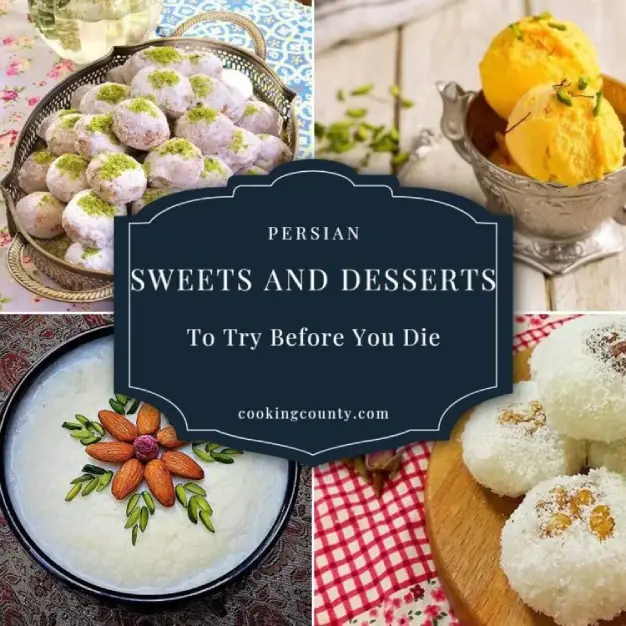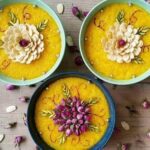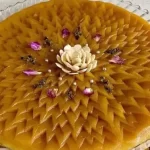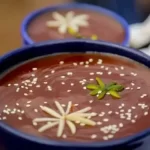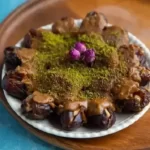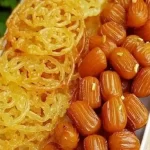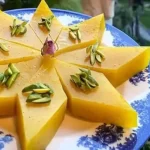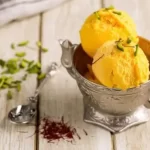Whether it is a simple date or an exciting and colorful dessert, It is pleasant to eat Persian sweets and desserts after the main meal.
Historical evidence considers Iranian people to be among the first owners of this global habit, and this means that Iranian ancestors were among the first to believe in eating dessert.

Therefore, it is not strange that Iran is rich in different types of delicious desserts, and you can find a special type of sweet and dessert in every part of Iran.
Some popular Persian sweets and desserts are a permanent part of the reception on special occasions or have become a symbol of religious vows and needs.
In the following, we introduce the most famous Persian sweets and desserts.

The Rich History of Iranian Desserts
Before it reached Europe, sugar initially made its way to the Middle East sometime after the first century AD. Prior to the usage of sugarcane, however, honey and other fruits like dates, apricots, and pomegranates served as the main sources of sweetness.
There were lots of pistachios, almonds, and sesame seeds, as well as flavors like rosewater, orange-flower bloom, saffron, and cardamom.
Confections were culinary status symbols that may be plated in gold or served in plaited baskets of ivory, creating an aromatic and aromatic food environment that many civilizations would have enjoyed.
Delicious Persian Sweets and Desserts
Below we have mentioned the most popular Persian Sweets recipes:
1- Halva: One of the Delicious Persian Desserts

Saffron halva is one of the oldest Persian desserts in Iran, and its name comes from the oldest Persian poems and stories. However, halva has become a constant basis for some special ceremonies and sometimes reminds us of bitter moments. Halva needs wheat flour, sugar, oil, saffron, rosewater, and cardamom.
The aromatic compounds like cardamom, saffron, and rosewater give halva an excellent taste. But this traditional and popular Iranian dessert is diverse, and people from many cities have their special recipes for making halva. Different types of halva can be accompanied by new ingredients such as eggs, corn starch, milk, almond kernels, white flour, rice flour, carrots, dates, etc. If you are interested in trying easy and inexpensive desserts, make different types of halva easily at home and enjoy their unique taste.
2- Sholeh Zard: Iranian Sweets for Nazri
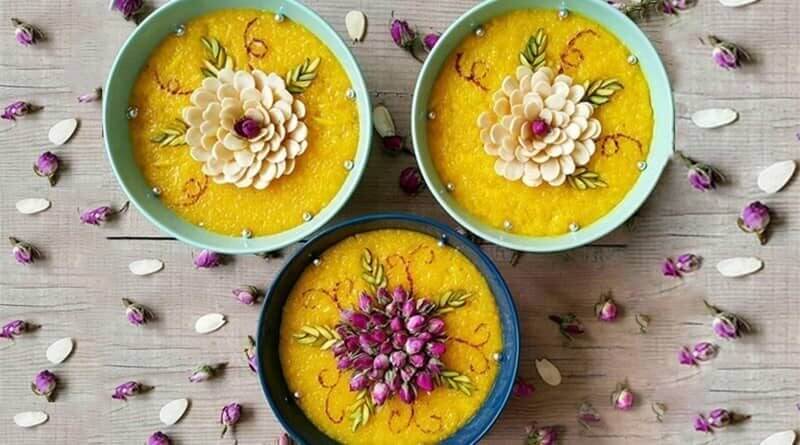
Making Sholeh Zard has become a kind of Iranian subculture and is sometimes associated with special ceremonies. This delicious Iranian dessert is mainly prepared on special religious occasions. The value of Sholeh Zard for Iranians is more than a simple dessert, and some tourists even refer to it as Nazri. Sholeh Zard is made of rice, rosewater, water, saffron, and sugar; The taste and aroma of Sholeh Zard have made it one of the famous traditional Iranian desserts at parties and various occasions, and of course, it has a high nutritional value. This dessert is often served with cinnamon and sliced almonds or pistachios, and sometimes cardamom is also used in its original aromatic composition.
3- Faloodeh Shirazi
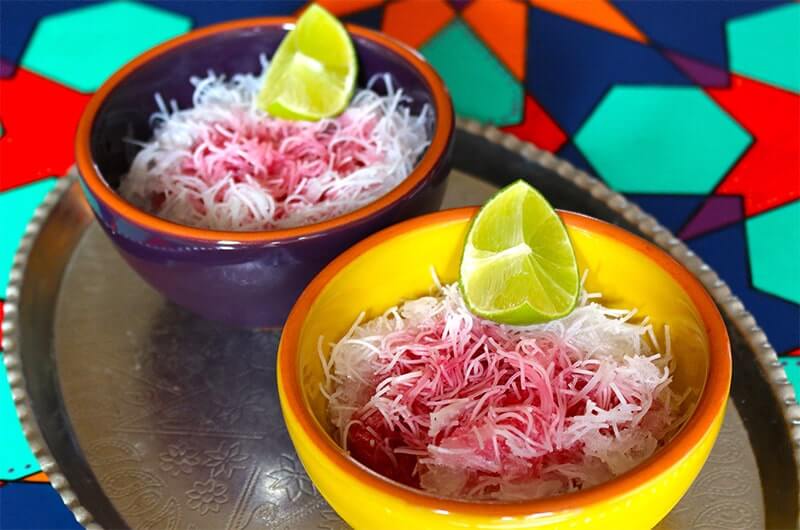
Faloodeh, or originally Paloudeh is one of the old and delicious Iranian desserts, which is the best dessert for summer. This dessert is obtained by turning melted starch into thin pastes. Faloodeh is a simple combination of these thin frozen noodles with sugar syrup and sometimes rosewater. Faloodeh can be found everywhere in Iran, But its different types go back to Shiraz, Kerman, and Yazd. Meanwhile, Faloodeh Shirazi is the most famous and popular of all. Shiraz is a mine of aromatic herbs; Falodeh Shirazi, accompanied by frozen noodles, lemon juice, and aromatic herbs, is an elixir to refresh the soul, especially in hot seasons. Paludeh Shirazi is sometimes served with ice cream and is especially popular among tourists.
4- Traditional Iranian ice cream
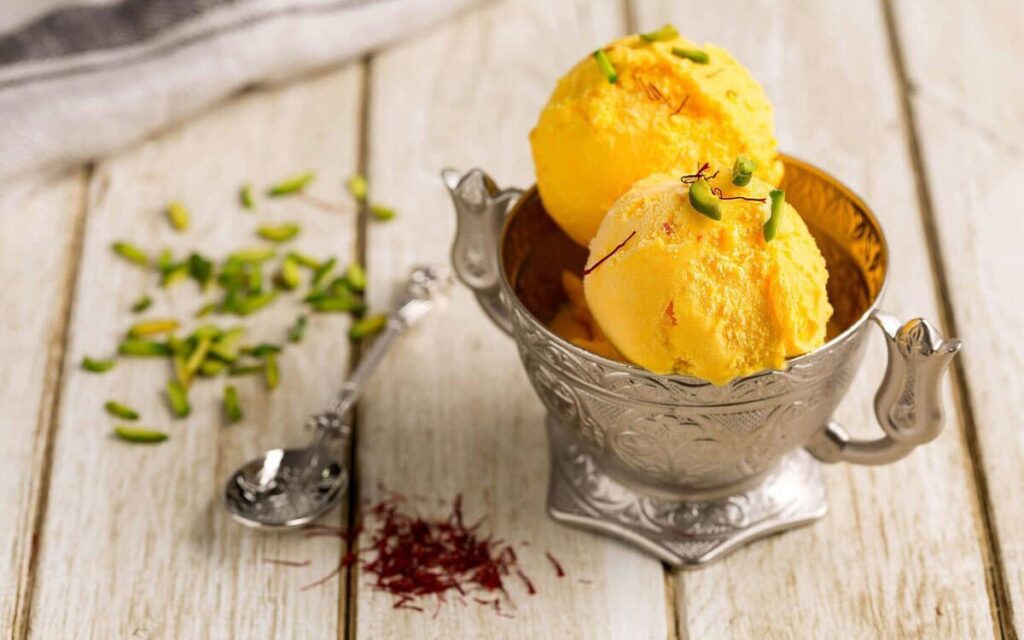
The history of ice cream is fascinating all over the world. But Iranian ice cream has another story. The aroma of rosewater and saffron is what distinguishes traditional Iranian ice cream. Saffron ice cream is one of the old deserts of Iran, whose creator intended to produce ice cream in harmony with the taste of the people of this region.
Akbar Malairi established the first traditional ice cream shop, Akbar Mashti, in Tehran and believed that ice creams made of saffron, rosewater, and fresh cream are more suitable for Iranians than ice creams from other countries. Traditional Iranian ice cream combines milk, cream, rosewater, saffron, sugar, flour, and pistachio slices. This very delicious dessert is served between two ice cream buns or a regular bowl, and sometimes it is served with Faloodeh. Traditional saffron ice cream has found its way to other parts of the world as one of the most valuable Iranian desserts.
5- Baslogh: One of the Best Iranian Desserts
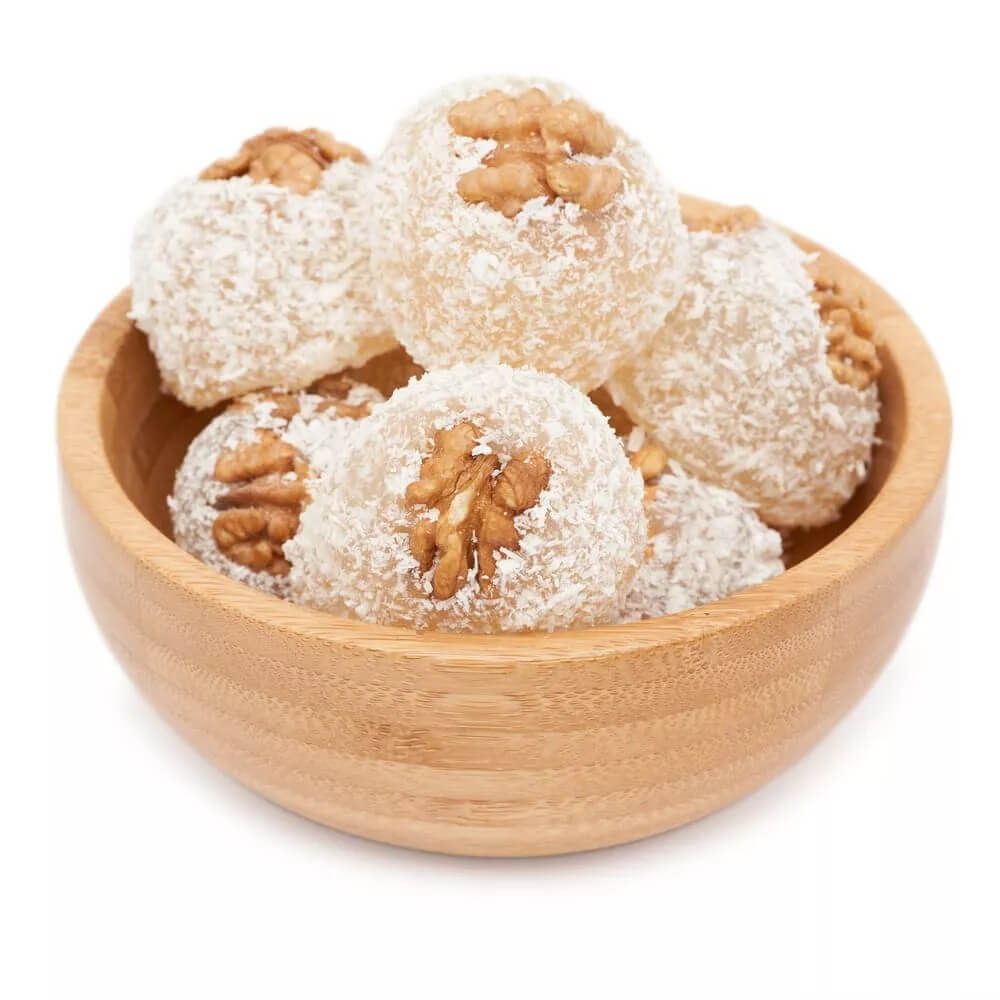
Baslogh is one of the simple homemade desserts that doesn’t need an oven. This dessert has Turkish origin, but it is served as a dessert among the Turkish-speaking Iranians in the cities of Tabriz and Ardabil. Among the different types of Basloogh, from jelly-colored baslogh to saffron basloogh, walnut baslogh is more popular than other types.
6- Shir Berenj: One of the Best Traditional Persian Desserts

Shir Berenj is a traditional Iranian food famous as an Iranian dessert. This simple and delicious dessert can be cooked in different ways, but its main ingredients are milk and rice, so it is better to use half-grain and full-fat milk to prepare simple rice milk.
Iranian rice is the best rice you can use to prepare Shir Berenj. Because it is tasty after cooking and becomes very sticky, using half-grain rice will make it softer. If you don’t use half-grain rice in the recipe for delicious Shir Berenj, you should pour more water into the rice and devote more time to crushing the rice.
How to cook Shir Berenj? To prepare Shir Berenj, brew some saffron until it becomes thick, then add rose water and sugar to the rice milk.
7- Kachi: A Popular, Traditional Persian Dessert
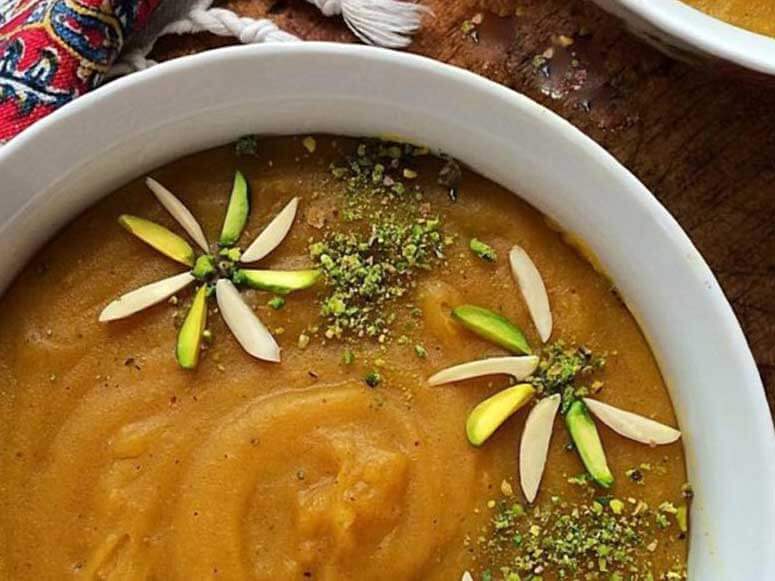
Tabrizi Kachi is very famous, and the people of Tabriz call this delicious and nutritious Iranian dessert “Quymaq” the people of Urmia call it “Doshab,” and the people of Kermani use 4 nuts to increase the strength of this delicious Iranian dessert.
Some add sugar, and in some areas, It is also customary to prepare Kachi by adding a little salt and turmeric. However, in general, the ingredients of this old and traditional Iranian dessert, regardless of the different names, with a bit of addition and subtraction of its ingredients, are similar in different regions of Iran.
8- Ghotab: Always Among the Persian Sweets Names

Ghotab is one of the oldest Iranian sweets, with many fans all year round, especially as a dessert for Nowruz or a simple Iranian dessert. Simple walnut Ghotab with spices such as cardamom and saffron is a traditional sweet of Yazd and Kerman provinces, and in these regions, it has its way of welcoming its fans all year round.
9- Yakh Dar Behesht: An Authentic Among the Iranian Desserts
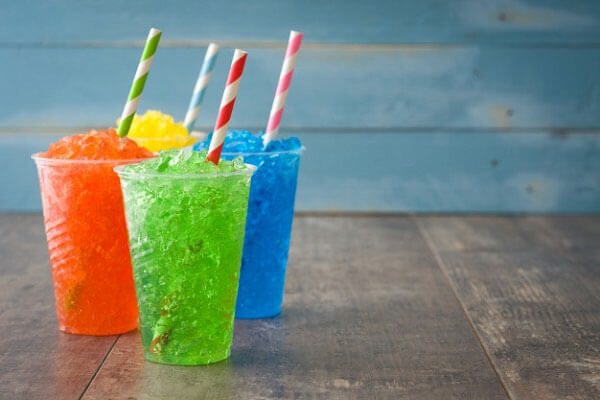
Yakh Dar Behesht is one of the oldest and most traditional cold drinks for hot summer days. It seems that the origin of Yakh dar Behesht is Isfahan, and when it went to Europe, it was called Frappe. In the distant years, ice was sold in heaven, making the summer heat bearable. Now that the tradition of ice in Behesht is slowly being forgotten, you can learn how to make ice in Behesht as an authentic and delicious Iranian dessert.
10- Masghati: One of the Best Persian Desserts
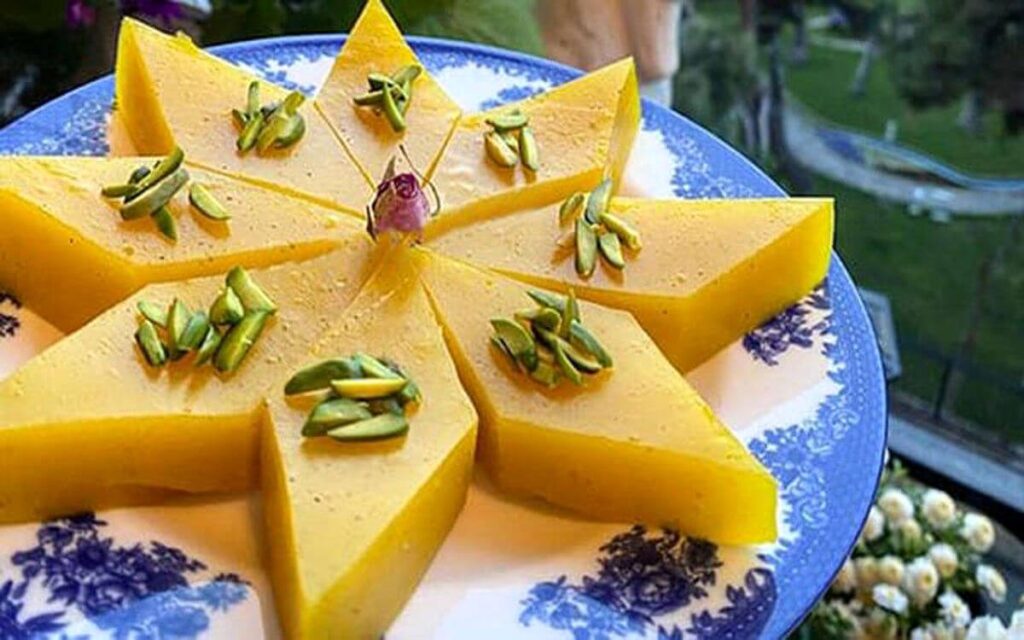
Masghati is one of the oldest halwa cooked in the southern provinces of Iran, especially Bushehr and Shiraz, and mainly in the Lar region, which is cooked for various religious occasions, celebrations, and mourning. This dessert is made with sugar, wheat, rosewater, and saffron.
Persian Dessert Recipes for Special Occasions
We have unique desserts or sweets for holidays like New Year’s, festivals, funeral rites, and memorials, much like every other culture in the globe.
Iran travel packages provide these opportunities, when you may watch the preparation of traditional Persian pastries and candies like samanu and shole Zard.
Nowruz Persian Dessert Recipes
In addition to being a time for preparing vibrant Persian pastries to wow guests, Nowruz is an ancient celebration. distinct parts of Iran have distinct pastries and desserts. Still, most Iranian homes will include Persian delicacies like Baklava, Qottab, Nan-e Berenji, and Aard Nokodchi.
In addition, samanu is a unique and traditional Iranian dessert that is only served at the New Year’s celebration. This sugar-free Iranian treat is as old as 500 AD.
Yalda Persian Sweets Names
We commemorate Yalda night, the final evening of autumn, each year. Iranians meet together on this longest night of the year in accordance with a long-standing tradition to avoid being alone and in the dark.
They eat nuts and baslogh, a delicious dessert, and perform poetry and stories. It’s a little, half-round confection with a walnut pattern that’s made of flour, sugar, and cardamom.
Ramadan and The Best Iranian Desserts
During the holy month of Ramadan, Muslims break their fast after sundown, and in order to do so, they need to eat foods high in energy. In addition to the unique meals we provide for this occasion, Iranian sweets and deserts also make excellent starts after prolonged periods of hunger.
The primary Persian dessert, bamieh and zolbia (jalebi), is used to adorn our meal. a flour and sugar syrup-based sweet that is juicy and crunchy.
What is the Main Feature of Persian Sweets and Dessert?
The sweetness of desserts is their main feature; sometimes, yogurt is also used as a diet dessert for people who don’t want to overeat sweets.
Ingredients that Make Iranian Desserts Unique
Here are the ingredients required for most of the Persian Desserts:
Saffron – The Red Gold
Saffron, commonly referred to as “Red Gold,” is a very precious and pricey spice with a lengthy history in the food and drug sectors. Over 90% of the world’s supply comes from Iran, which is the leading producer in the world. With 390 tons of saffron being cultivated and sold, Iran has the best wholesale saffron industry in the whole nation.
The Fragrant Touch of Rose Water
Since ancient times, Iranians have used rose water, known as “Golab” in Persian, as food, medicine, and even perfume. Iranians like rose because it promotes happiness and relaxation and is utilized both during celebrations and times of mourning.
Fruits and Nuts Dried
Iran Dried fruits are mostly dried either naturally, with sun drying, or with specialized dryers such as heated wind tunnel dryers or dehydrators. Dried fruit has mostly kept the nutritional value of fresh fruit. Iranian nuts have a hard shell and a seed that is usually edible and packed with nutrients.
What Foods Do Iranian Desserts Include?
Types of halva, faloodeh, ghotab, masghati, Sholeh Zard, Shir Berenj, etc., are among the list of Iranian desserts. Don’t forget that candies and similar foods are not considered desserts despite being sweet.
Over time, the type of Iranian family parties has changed. Putting any kind of food in front of the guest is no longer possible. People prefer to serve different kinds of desserts at their parties.
For example, we can refer to Yazdi Baklava, baslogh, and walnut ghotab. However, people’s tastes are very different. Some people believe that eating dessert after the main meal is inappropriate.
Others like to have a snack or a drink. If you are the second type, you can learn how to prepare several types of Persian desserts.
Why Iranian Persian Sweets and desserts Are Special?
Iranian pastries are delicious, distinctive, and savory. Depending on the country of origin, each is unique from the others. Iranian sweets provide a wide variety of alternatives for everyone, including Iranian Baghlava, rice puddings, ice cream and traditional cakes.
Iranian pastries are notorious for using a lot of saffron, which makes them difficult to resist. They are renowned for their overpowering sweetness and slight rosewater undertone.
Also visit: Tomato Salad Recipe
FAQs About Iranian Sweets Recipes
- What are the most popular Persian dessert recipes in Iran?
Masghati, Sholeh Zard, Ghotab, Kachi, etc., are among the most famous persian sweets and desserts in Iran.
- Is Shir Berenj considered an Iranian dessert?
Shir berenj is both served for dessert and the main course.
- Which elements are frequently found in Persian desserts?
Nuts, dried fruits, rose water, saffron, sugar, and flour are frequently found in Persian desserts.

